Who Is Erik Ten Hag?
Following the sacking of Marcel Keizer in December 2017, Erik ten Hag took over as Ajax Manager.
Since his appointment he has won the Eredivisie title in the 2018-19 season, as well as the KNVB Cup, on top of a well-documented run to the Champions League semi-final, where they were knocked out in the last minute of the game thanks to a goal from Tottenham’s Lucas Moura.
Since then ten Hag’s side have continued to dominate domestically, and are three points clear at the top of the league with AZ Alkmaar sat just behind.
There will not be a repeat of last season’s Champions League heroics, however, yet Ajax fans will no doubt believe they have a strong chance of regaining the Europa League title having been knocked out in the Champions League group stages this time round.
The most obvious task ten Hag faced following last season was replacing Frenkie de Jong and Matthijs de Ligt, with the two youngsters leaving in the summer for Barcelona and Juventus, respectively.
Lisandro Martínez was signed in the summer and was expected to fill in at centre-back but has found plenty of minutes in central midfield as well as at the back, with Joël Veltman and Perr Schuurs seeing far more game time at centre-back in the post-De Ligt era.
This tactical analysis will look at Erik Ten Hag tactics he has been using at Ajax to get such excellent results.
Erik Ten Hag Style Of Play – Building from the back
Ten Hag predominantly uses a 4-2-3-1 formation, having used this in 84.5% of games over the last two seasons, however, a 4-3-3 has also been used on occasion.
With an overall win percentage of 73.27% and an overall goal difference of +192 from 101 games as Ajax manager.
It is fair to say ten Hag’s philosophy has created an Ajax side that are a successful attacking outfit.
Ajax build up patiently from the back with both centre-backs and a pivot creating a triangle, and engaging in a variety of interchanges between them as well as rotating positionally to build play and help break the initial press.
This back three encourage the opposition to push forward and engage, opening up spaces in more attacking areas for them to play into.
It is often the case in the Eredivisie where Ajax face sides operating defensively in a low block, so ten Hag looks to bring this forward.
They are used to having large periods of possession in the Eredivisie, and have averaged 64.3% of possession in domestic games so far this season – a league-high, as well as making 582 passes per game.
The analysis below demonstrates how Ajax look to build possession.
We can see that with Onana in possession, his two centre-backs split either side, whilst one of the two pivots will drop in and create a triangle.
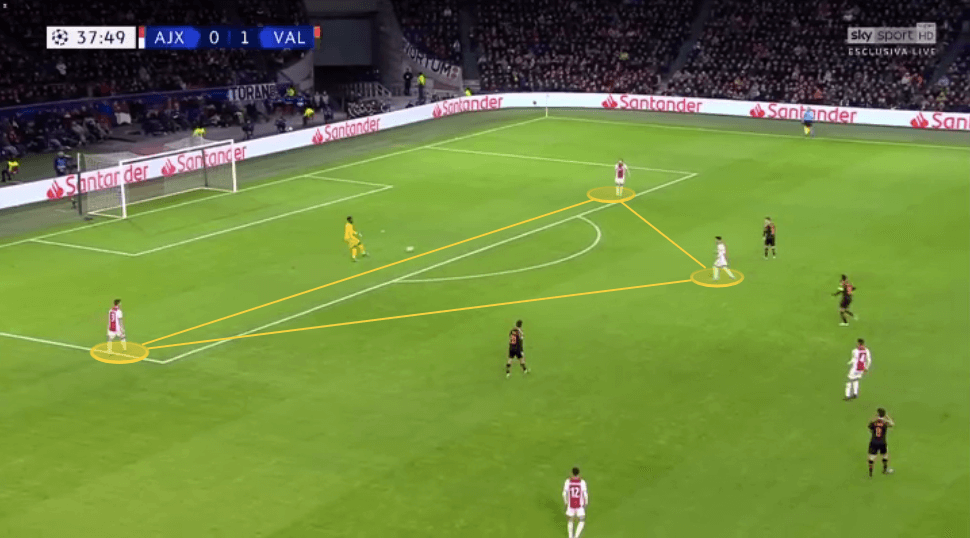
Onana frequently plays short into one of these three players.
The centre-backs often split incredibly wide.
If they do this the pivot will drop directly in between them to occupy the central space.
By doing this it allows their full-backs to push high as the centre-backs are able to give the width.
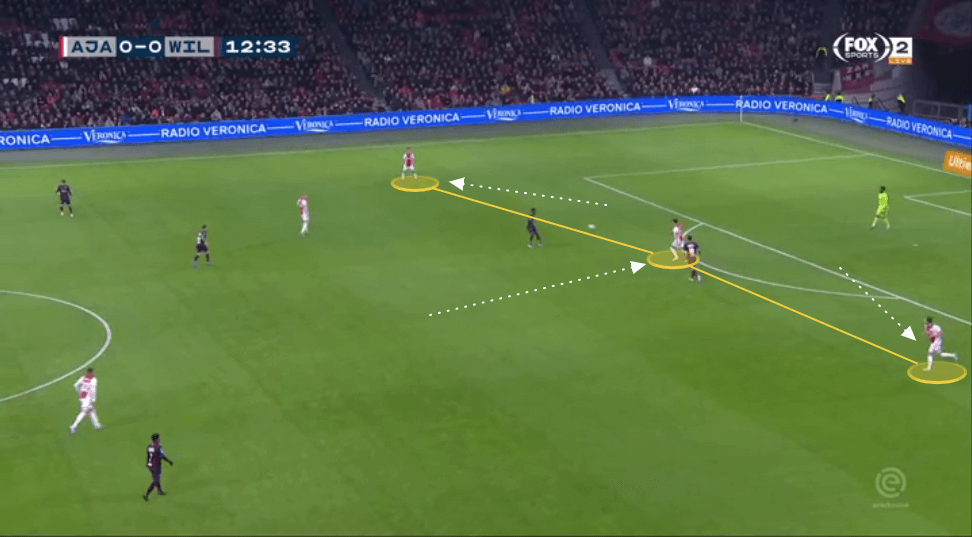
Should the opposition engage in a press, the players are wide enough to create a space in front of them, which they can move into themselves to continue building their attack.
They then look for diagonal passes to break the lines and play forward into their attacking midfielders.
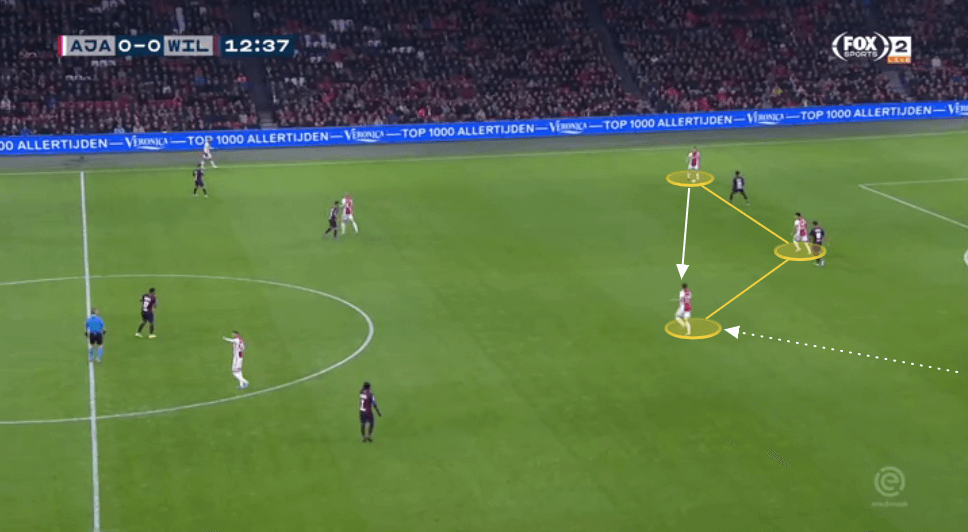
Hakem Ziyech is given a lot of freedom with his movement and will often drift into the half-spaces in deeper areas to receive these diagonal passes from one of the back three.
Although they are efficient at playing the ball forward when given the opportunity, they do not rush the process, and Ten Hag values ball security and keeping the ball on the floor.
Just 7.17% of their passes in the Eredivisie this season have been long passes.
Daley Blind is vital to this process and has seen his career rejuvenated under ten Hag.
Everything begins with the ex-Manchester United defender, who is an excellent passer.
He has recorded 180 more passes than anyone else in the league this year and naturally has more ball progressions than anyone else, with an astounding 9.62 per minute.
The importance of wide players
If we analyse Ajax’s positional attacks they provide us with a sense of their attacking tendencies.
They have had the majority of positional attacks from the left side,
444, compared with 378 from the centre of the pitch and the fewest from the right side,just.
Their xG per attack from the left has been 0.03 xG per attack, whereas from the middle it is 0.05 per attack.
This does not seem like a huge difference per attack
. However, in all competitions, the left has an xG of 12.81, whereas in the middle,it was a total of 17.17 xG.
This compared to a mere 5.36 xG from the right-side, highlights where they are most dangerous.
Nevertheless ten Hag uses wide players on either side that can hurt the opposition.
David Neres, Quincy Promes and Ziyech are three individuals used in such positions, and Promes and Ziyech in particular are two of the most potent attacking talents playing outside of the top five leagues.
Unsurprisingly with this talent on their flanks, plenty of their goals coming from crosses.
They make 18.85 crosses per game, over three more than the second-most in the league.
On top of this they recorded a 34.1% completion, the second-highest amount in the league.
Ziyech makes more crosses than anyone and averages 0.78 assists per game, which is the highest in the league.
Despite the difference in xG between both flanks, it is interesting to note that the majority of their crosses come from the right-flank, with 191 coming from the right side, compared to 126 from the left.
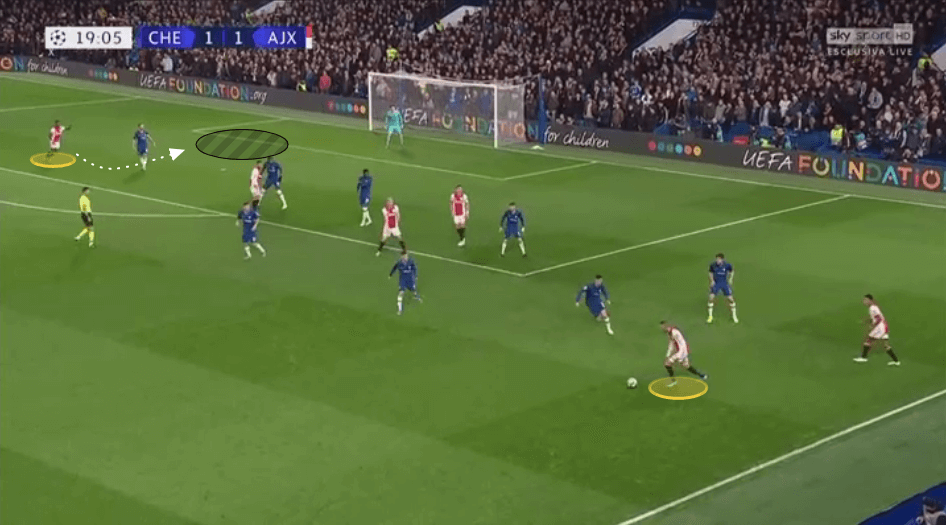
They are effective crossing from deeper areas, particularly with the opposition defence sat close to the edge of the 18-yard box, with space in behind.
In these situations ten Hag likes an inswinging cross from deep to be played to the furthest player on the opposite side.
Ziyech is particularly fond of dropping into areas where he can whip balls across defences, looking to pick out the furthest player in the space between the backline and the goalkeeper.
These wide players are not just dangerous crossers.
Ajax have had over ten different goalscorers in all competitions this season, and their wingers are one of their most consistent threats.
Promes is their top scorer in the league this year with ten, whilst Ziyech has taken the most shots in the league with 5.29 per game.
In attack, ten Hag always keeps a player wide on the opposite flank as an outlet so Ajax can quickly switch play and still maintain an attacking threat, as we can see below.
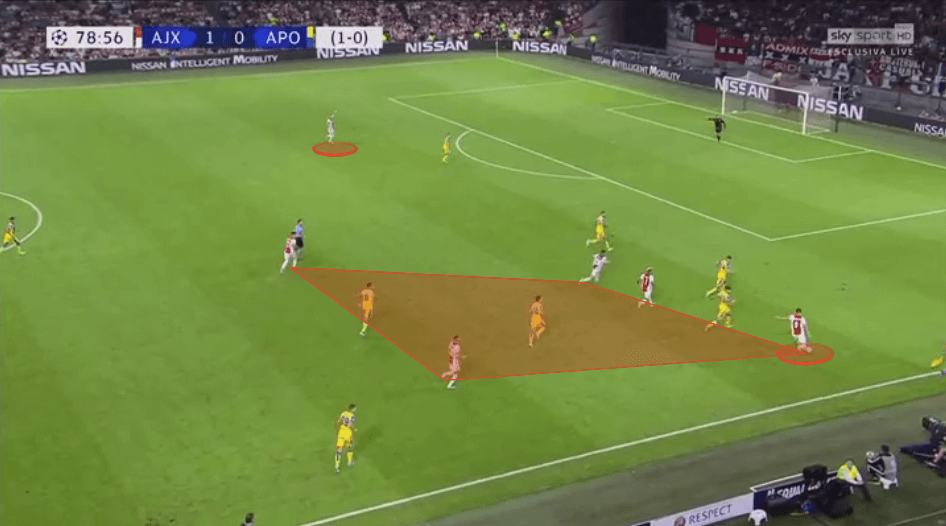
Erik Ten Hag Attacking shape
Their approach to get the ball into dangerous areas is incredibly successful.
The majority of their goals come from inside the box, where they average 39.88 touches in the box.
To put this in context this is 13 more than the second-highest in the league – AZ Alkmaar once more.
Four of the top five in the league for touches in the box come from Ajax.
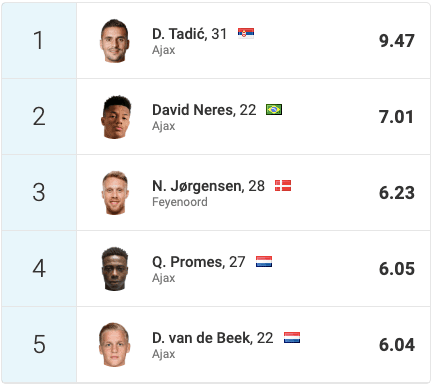
Ajax push seven or even eight players forward in attack and are able to play quick passes between one another before looking for the killer through pass.
They are constantly able to complete passes in these tight spaces around the box with 27 per game into this area.
The league average is just 10.
Donny van de Beek’s positioning is interesting and his movement facilitates Ajax’s excellent passing in the final third.
He plays in front of Ajax’s double pivot, however, when they attack he pushes forward, vacating the central space in midfield, and plays alongside Dušan Tadić, effectively as another centre-forward.
In the image below, he occupies the centre-back position, while Tadić is able to move into the vacant space.
By pushing forward he has to be picked up by the centre-back, and this gives Tadić the space to receive in between defenders.
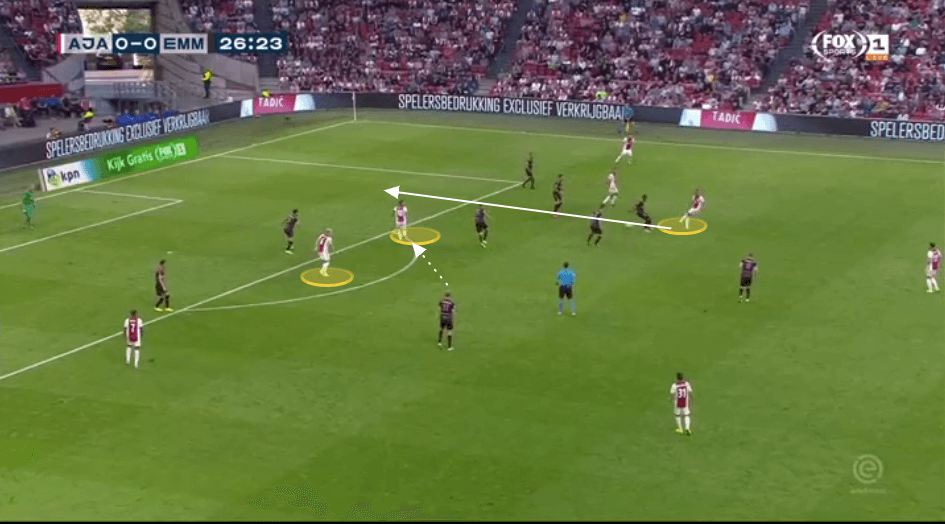
Six of the league’s top ten for passing accuracy into the final third are Ajax players, and other than Promes, they are all players that operate in central areas with Schuurs and Veltman centre-backs, Blind a centre-back-cum-pivot, Marin a pivot himself and van de Beek a central-attacking midfielder.
This not only tells us that Ajax builds up in central areas but is also blessed with excellent passers who are particularly adept at picking out players in the final third.
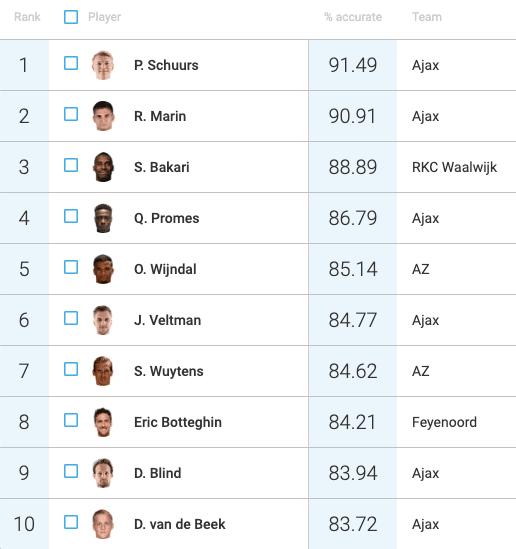
However, it is not just the space in between opposition defenders where Ajax are able to consistently find joy.
Their front four generally play very close together and this creates other opportunities.
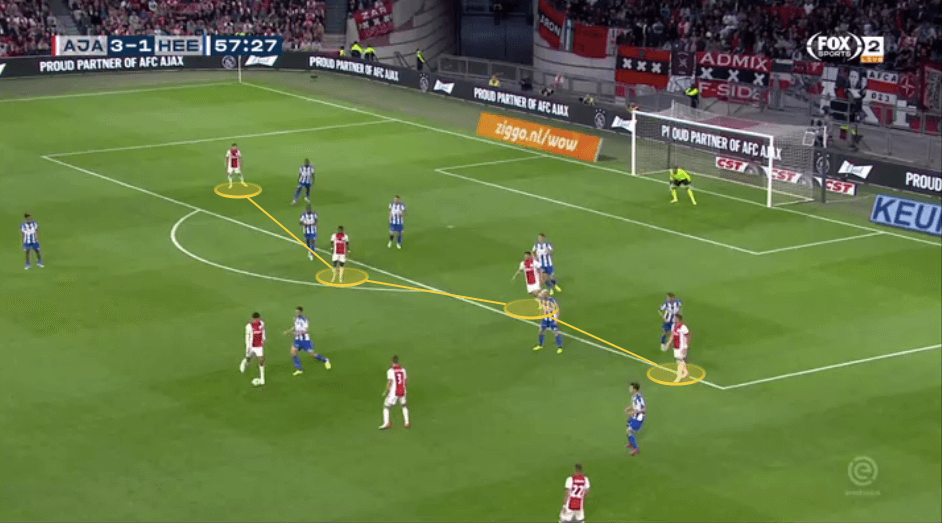
The front four play tight to the opposition back four, occupying both of the full-backs and centre-backs.
By playing narrowly there is of course space on either flank, and ten Hag expects his full-backs to push on and penetrate this space.
This creates an easy attacking outlet for anyone of the midfield three in possession of the ball to seek out.
The full-backs can get behind the defence but more often look to get to the line and pull the ball back across goal.
To crate this midfield three, following the central-attacking midfielder becoming a centre-forward, one of the full-backs will often be seen dropping more central to ensure the remaining midfield two are not overrun, whilst the other full-back will make the forward run.
In the image below, VV-Venlo’s defence is occupied by Ajax’s front four, which leaves space on both flanks.
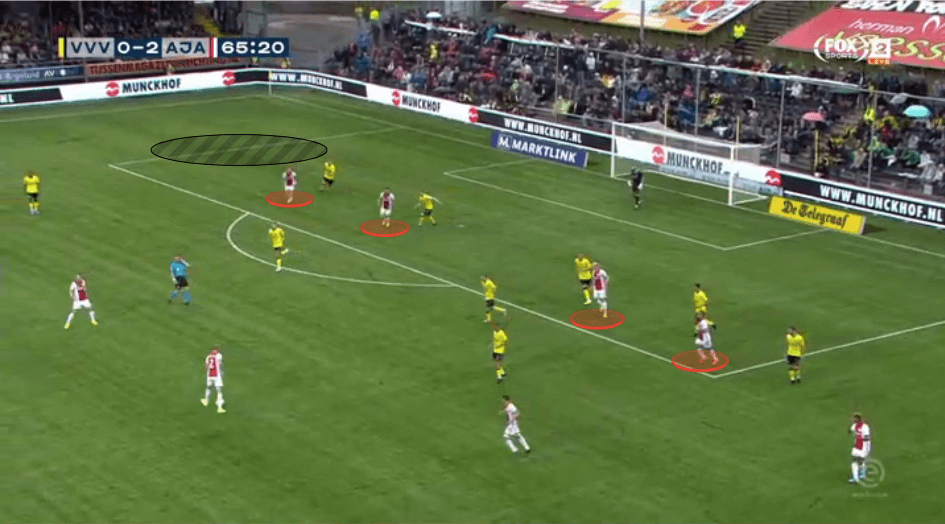
As the ball is played into a more advanced position centrally, the Venlo defence becomes particularly narrow, creating even more space on the flank.
Sergio Taglicafico is able to make a diagonal inward run into this space and receive behind the Venlo defence.
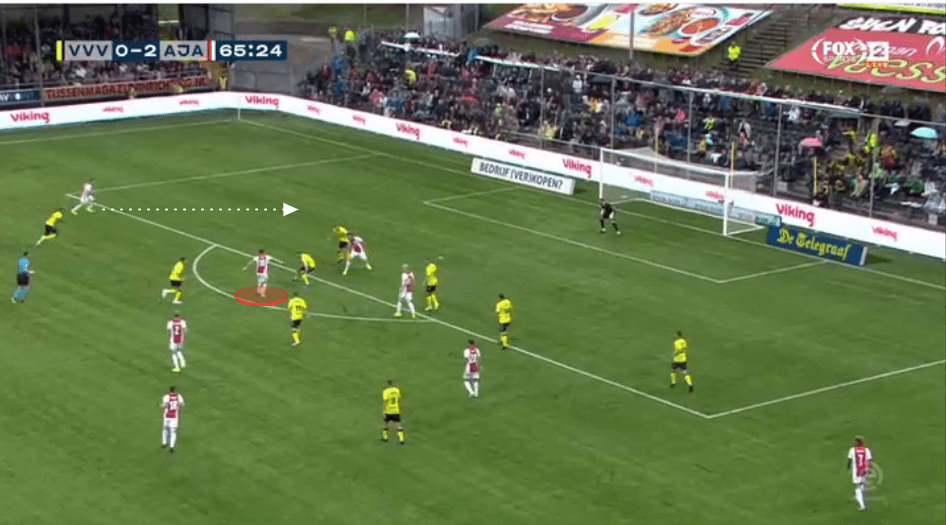
The high positioning of their full-backs can be used for the opposite effect too, which can be just as damaging.
Should the opposition full-backs spread wide to cover their runs, then this creates spaces inside, particularly in the half-spaces for Ajax’s forwards to move into.
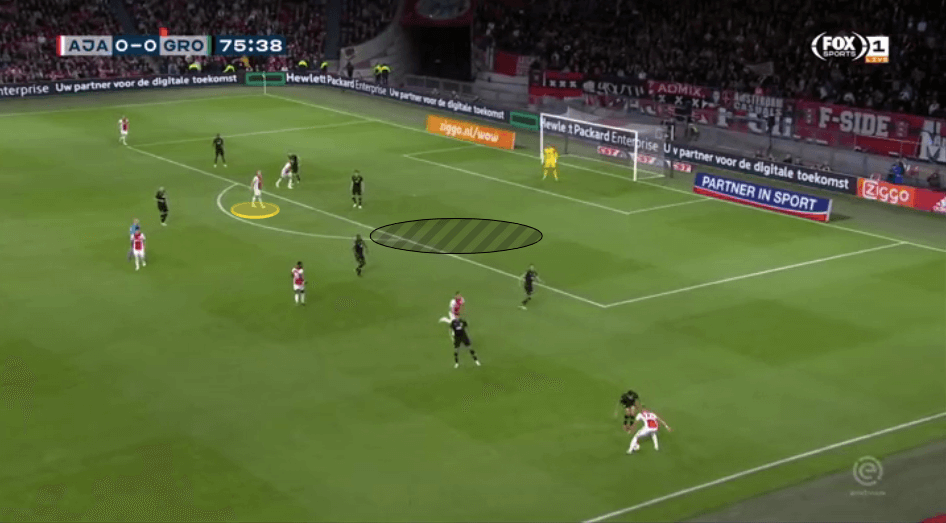
When they can create space between the full-back and centre-back, they look to play their forwards into these areas.
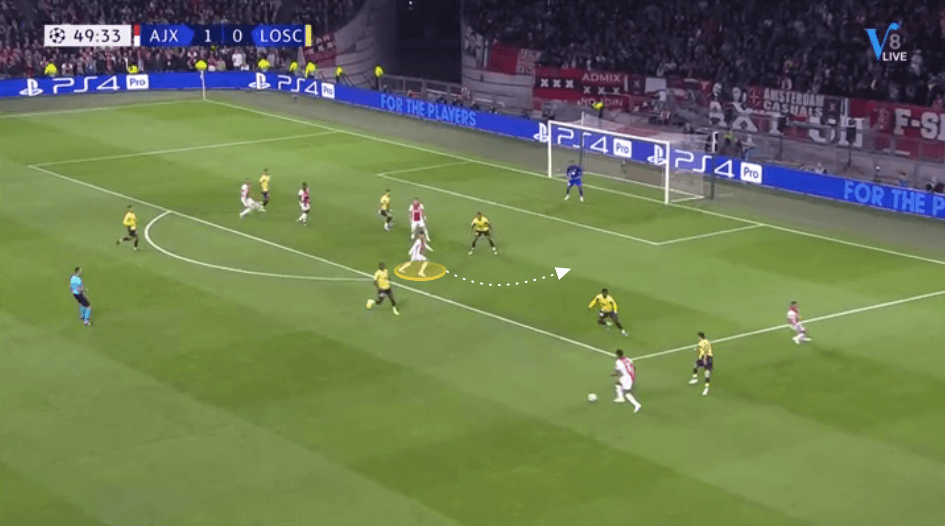
The Ajax press Under Erik Ten Hag
Ajax are not just leaders in the league for their attacking prowess though.
Under ten Hag they are an aggressive pressing side that look to win the ball back as quickly as possible.
So far this season, they have had 7.82 Passes Per Defensive Action, once again the highest in the league for this metric.
Their press is orthodox.
The frontman generally engages either of the opposition full-backs, while three or four players close passing lanes and delay the press until the ball is moved laterally by the opposition.
We can see their general pressing shape below.
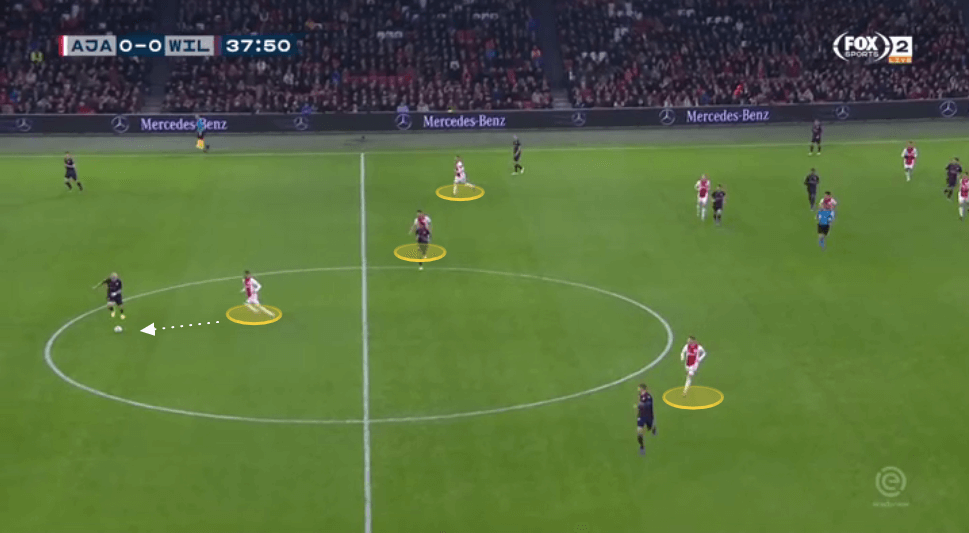
If the opposition have possession in the Ajax half, Ajax will drop deep and look to close off passing lanes, forcing the side to recycle the ball.
As the opposition does this, they will press forward and look to prevent them from switching the ball easily, blocking off lateral and vertical passing lanes.
This encourages the opposition to play a long ball forward, which Ajax are comfortable dealing with.
Ten Hag’s side are second only to FC Groningen in Aerial Duels win percentage.
In the image below, Ajax press with a front two, with one forward pressing the ball-carrier, and the second forward stopping the lateral pass, forcing the defender to play long.
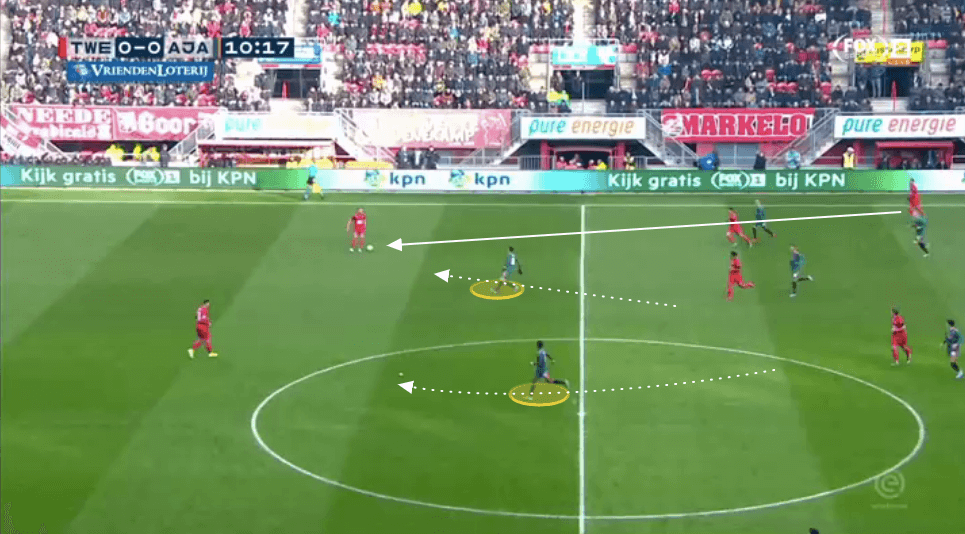
Throughout much of Ajax’s pressing game, we can see the use of curved runs to block passing lanes and ensure the opposition are forced to play into particular areas of the pitch.
Below is an example of this as Ziyech curves his run to stop the Willem II goalkeeper from being able to pass into his right-sided centre-back.
Due to the positioning of Ziyech’s two teammates in this press, the keeper has no choice but to play long, and to play to the left-side of the pitch.
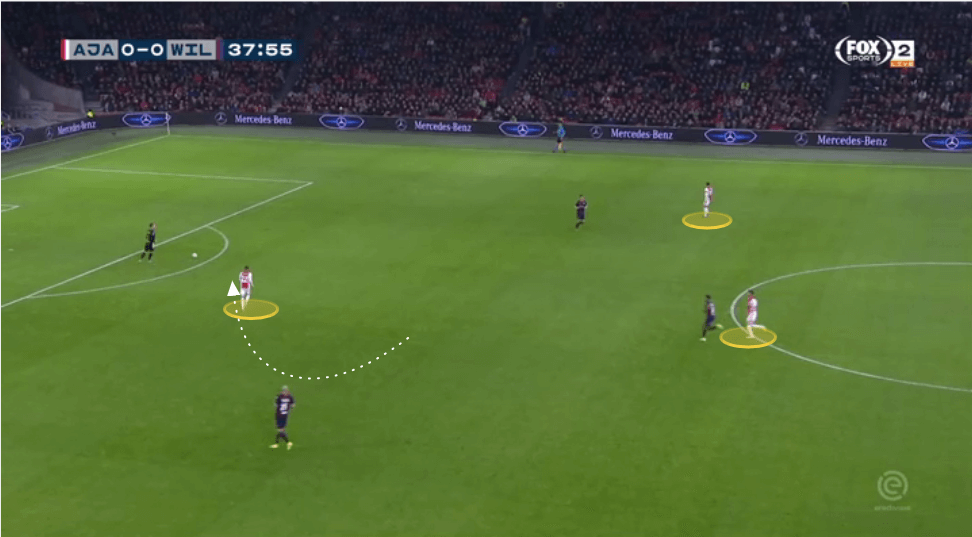
Conclusion
Ten Hag’s Ajax have clear principles of play.
In attack they are comfortable and patient on the ball, playing fluid passing football which starts from the back.
This is not unusual for an Ajax side.
What is less common is his desire to pin down opposition defences and lull their back four into man-marking their most forward-attacking players.
With their exceptional creativity from midfield, they are able to manipulate the positioning of the opposition’s back four, creating space in between them or behind them for players to be played into with well-timed, accurate through balls.
They are also dedicated to utilising the pace and crossing ability of their wide players, who are just as dangerous crossing from deep areas looking for players moving off of the opposite side opposition full-back, as they are dribbling past their own opposition full-back, and pulling the ball back into the second six-yard box for the likes of van de Beek and Tadic to run onto.
Defensively, they are an organised side that is effective at closing off passing lanes with their positioning. They press with intensity and at angles to ensure the ball is played into areas that Ajax can defend easily, most often a long ball towards their aerially dominant centre-backs.

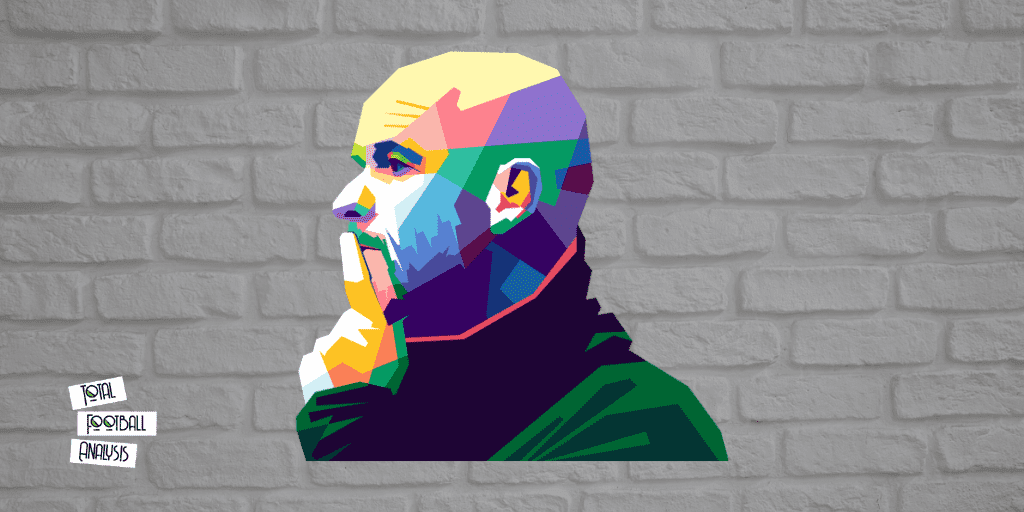



Comments